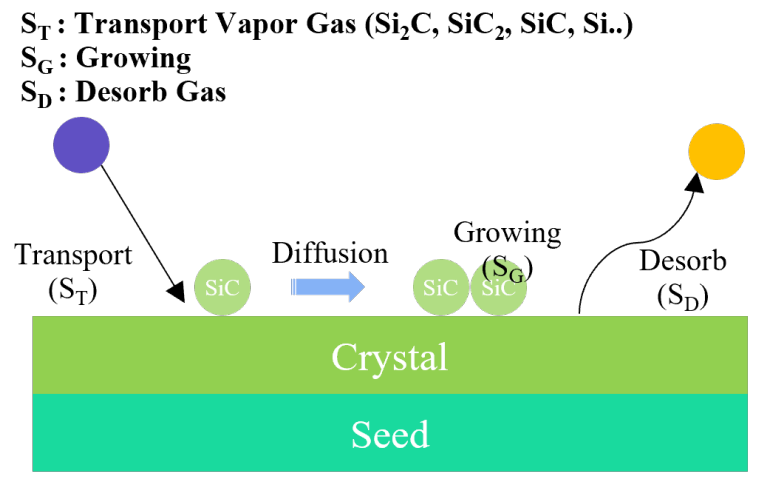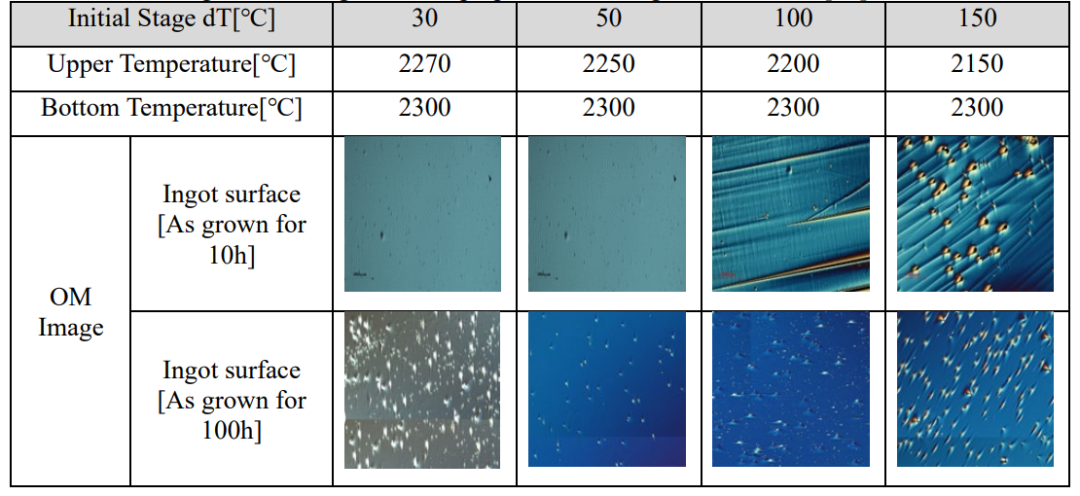
- English
- Español
- Português
- русский
- Français
- 日本語
- Deutsch
- tiếng Việt
- Italiano
- Nederlands
- ภาษาไทย
- Polski
- 한국어
- Svenska
- magyar
- Malay
- বাংলা ভাষার
- Dansk
- Suomi
- हिन्दी
- Pilipino
- Türkçe
- Gaeilge
- العربية
- Indonesia
- Norsk
- تمل
- český
- ελληνικά
- український
- Javanese
- فارسی
- தமிழ்
- తెలుగు
- नेपाली
- Burmese
- български
- ລາວ
- Latine
- Қазақша
- Euskal
- Azərbaycan
- Slovenský jazyk
- Македонски
- Lietuvos
- Eesti Keel
- Română
- Slovenski
- मराठी
- Srpski језик
Achieving High-Quality SiC Crystal Growth through Temperature Gradient Control in the Initial Growth Phase
Introduction
Silicon carbide (SiC) is a wide-bandgap semiconductor material that has garnered significant attention in recent years due to its exceptional performance in high-voltage and high-temperature applications. The rapid advancement of Physical Vapor Transport (PVT) methods has not only improved the quality of SiC single crystals but has also successfully achieved the fabrication of 150mm SiC single crystals. However, the quality of SiC wafers still requires further enhancement, particularly in terms of reducing defect density. It is well-known that various defects exist within grown SiC crystals, primarily due to an insufficient understanding of the defect formation mechanisms during the SiC crystal growth process. Further in-depth research on the PVT growth process is necessary to increase the diameter and length of SiC crystals while also enhancing the crystallization rate, thereby accelerating the commercialization of SiC-based devices. To achieve high-quality SiC crystal growth, we focused on temperature gradient control during the initial growth phase. Since silicon-rich gases (Si, Si2C) may damage the seed crystal surface during the initial growth phase, we established different temperature gradients in the initial stage and adjusted to constant C/Si ratio temperature conditions during the main growth process. This study systematically explores the various characteristics of SiC crystals grown using modified process conditions.
Experimental Methods
The growth of 6-inch 4H-SiC boules was performed using the PVT method on 4° off-axis C-face substrates. Improved process conditions for the initial growth phase were proposed. The growth temperature was set between 2300-2400°C, and the pressure was maintained at 5-20 Torr, in an environment of nitrogen and argon gas. 6-inch 4H-SiC wafers were fabricated through standard semiconductor processing techniques. The SiC wafers were processed according to different temperature gradient conditions in the initial growth phase and etched at 600°C for 14 minutes to evaluate defects. The etch pit density (EPD) of the surface was measured using an optical microscope (OM). The full width at half maximum (FWHM) values and mapping images of the 6-inch SiC wafers were measured using a high-resolution X-ray diffraction (XRD) system.
Results and Discussion

Figure 1: Schematic of SiC Crystal Growth Mechanism
To achieve high-quality SiC single crystal growth, it is typically necessary to use high-purity SiC powder sources, precisely control the C/Si ratio, and maintain constant growth temperature and pressure. Additionally, minimizing seed crystal loss and suppressing the formation of surface defects on the seed crystal during the initial growth phase are crucial. Figure 1 illustrates the schematic of the SiC crystal growth mechanism in this study. As shown in Figure 1, vapor gases (ST) are transported to the seed crystal surface, where they diffuse and form the crystal. Some gases not involved in growth (ST) desorb from the crystal surface. When the amount of gas on the seed crystal surface (SG) exceeds the desorbed gas (SD), the growth process proceeds. Therefore, the appropriate gas (SG)/gas (SD) ratio during the growth process was studied by changing the position of the RF heating coil.

Figure 2: Schematic of SiC Crystal Growth Process Conditions
Figure 2 shows the schematic of the SiC crystal growth process conditions in this study. The typical growth process temperature ranges from 2300 to 2400°C, with the pressure maintained at 5 to 20 Torr. During the growth process, the temperature gradient is maintained at dT=50~150°C ((a) conventional method). Sometimes, uneven supply of source gases (Si2C, SiC2, Si) may result in stacking faults, polytype inclusions, and thus degrade crystal quality. Therefore, in the initial growth phase, by changing the position of the RF coil, dT was carefully controlled within 50~100°C, then adjusted to dT=50~150°C during the main growth process ((b) improved method). To control the temperature gradient (dT[°C] = Tbottom-Tupper), the bottom temperature was fixed at 2300°C, and the top temperature was adjusted from 2270°C, 2250°C, 2200°C to 2150°C. Table 1 presents the optical microscope (OM) images of the SiC boule surface grown under different temperature gradient conditions after 10 hours.

Table 1: Optical Microscope (OM) Images of SiC Boule Surface Grown for 10 Hours and 100 Hours under Different Temperature Gradient Conditions
At an initial dT=50°C, the defect density on the SiC boule surface after 10 hours of growth was significantly lower than that under dT=30°C and dT=150°C. At dT=30°C, the initial temperature gradient may be too small, resulting in seed crystal loss and defect formation. Conversely, at a higher initial temperature gradient (dT=150°C), an unstable supersaturation state may occur, leading to polytype inclusions and defects due to high vacancy concentrations. However, if the initial temperature gradient is optimized, high-quality crystal growth can be achieved by minimizing the formation of initial defects. Since the defect density on the SiC boule surface after 100 hours of growth was similar to the results after 10 hours, reducing defect formation during the initial growth phase is the critical step in obtaining high-quality SiC crystals.

Table 2: EPD Values of Etched SiC Boules under Different Temperature Gradient Conditions
Wafers prepared from boules grown for 100 hours were etched to study the defect density of SiC crystals, as shown in Table 2. The EPD values of SiC crystals grown under initial dT=30°C and dT=150°C were 35,880/cm² and 25,660/cm², respectively, whereas the EPD value of SiC crystals grown under optimized conditions (dT=50°C) significantly reduced to 8,560/cm².

Table 3: FWHM Values and XRD Mapping Images of SiC Crystals under Different Initial Temperature Gradient Conditions
Table 3 presents the FWHM values and XRD mapping images of SiC crystals grown under different initial temperature gradient conditions. The average FWHM value of SiC crystals grown under optimized conditions (dT=50°C) was 18.6 arcseconds, significantly lower than that of SiC crystals grown under other temperature gradient conditions.
Conclusion
The effect of initial growth phase temperature gradient on SiC crystal quality was studied by controlling the temperature gradient (dT[°C] = Tbottom-Tupper) by changing the coil position. The results showed that the defect density on the SiC boule surface after 10 hours of growth under initial dT=50°C conditions was significantly lower than that under dT=30°C and dT=150°C. The average FWHM value of SiC crystals grown under optimized conditions (dT=50°C) was 18.6 arcseconds, significantly lower than that of SiC crystals grown under other conditions. This indicates that optimizing the initial temperature gradient effectively reduces the formation of initial defects, thereby achieving high-quality SiC crystal growth.**




